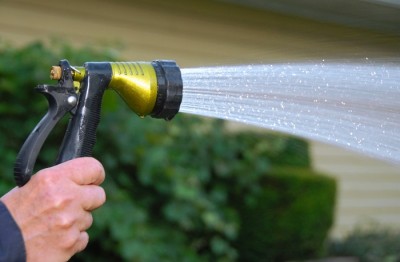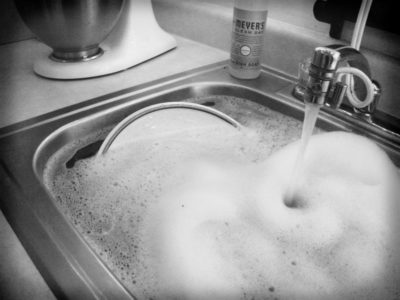With the National Weather Service predicting drought conditions to continue over much of the nation this summer, water is more of a precious commodity than ever. Yet despite new technologies such as low-flow showerheads, efficient washing machines and dishwashers and low-flush toilets, the average American household uses about 400 gallons of water every day.
Even if you don’t live in a drought-stricken area, when you cut back on water, you can save money and help conserve this vital natural resource. While you probably have heard certain tried and true tips such as turning off the sink faucet when you brush your teeth and checking for any leaks in your toilet, faucets and water hose connections, there are many other ways you can save water around your home. Here are a few water conservation steps you may not have considered.
The bathroom. Not surprisingly, we use the most household water in the bathroom. More than one-fourth of our household water is used by the toilet alone.
One of the best and least expensive ways to save water in the bathroom is by using a shower bucket. Most of us let the water run in the shower while we wait for the water to heat up to a comfortable temperature. By placing a bucket under the shower head flow, you can collect this water until you are ready to get in. You can then use this bucket to refill your toilet tank when you flush — or save it to water your plants.
Another easy way to cut down on water is to turn off the water during your shower while you are lathering up or putting on shampoo. You can turn it back on again to rinse. Think that little bit of time won’t help? Just a four-minute shower uses about 20 to 40 gallons of water.
Ultra Efficient Water Filter Fits In Your Pocket!
Similarly, there is no need to keep the faucet running continually while you are shaving, washing your face or brushing your teeth. You will save a surprising amount of water by keeping a few inches of warm water in the sink to rinse your razor and by turning the faucet off and then on again when you need to rinse your face or mouth.
The kitchen. About 8 to 10 percent of our home indoor water use takes place in the kitchen. Here are some water-saving ideas for this busy room of your house:
- Reuse cooking water. Set a pot under your colander when your pasta is cooked. Use it later to water your plants. Similarly, save the water you use for steaming or boiling vegetables. You can use it for soup stock.
- A glass a day. Don’t use a different glass every time you reach for a drink of water. Provide each person in the family with his or her own recognizable glass to use and reuse throughout the day.
-
Scrape off food but don’t rinse dishes before loading the dishwasher. Wait to run the machine until it is full for best water efficiency.
- If you wash dishes by hand, plug the sink and reuse the soapy water before rinsing with clean water.
- To avoid running the faucet to get it cold enough to drink, keep a bottle of drinking water in the fridge.
- Most sink garbage disposal units require a lot of water to run properly. Minimize your use by maintaining a compost pile instead.
- Thaw food from the freezer in the refrigerator overnight rather than using running water to defrost it.
The laundry room. Avoid the wasted water of small loads in your washing machine by combining items in full loads whenever possible. If you need to wash some items separately, make sure you adjust the water level accordingly. Only use the extra rinse cycle (which can often use an extra five gallons or so of water) when absolutely necessary.
Around the house and yard. Do you pour water from your dehumidifier down the drain? Use it to water your indoor or outdoor plants instead.
When you have household items, lawn furniture, grill accessories or even pets that need to be rinsed off with a hose, do it outside in your yard. As long as you are avoiding the use of harmful cleaning agents, you can water your yard at the same time as you clean. Use buckets to catch any excess spray from the hose.
In the summer months, or in dry climates, a household’s outdoor water use can increase as much as 70 percent, according to Environmental Protection Agency statistics. Here are few more ideas to consider:
- Collect rain water in a barrel or trash can. One easy way is to set the barrel under a gutter downspout. You can use this “free” water for all kinds of purposes around the home and garden.
- Instead of hosing off driveways, sidewalks and steps, sweep them instead.
- Wash your car with water from a bucket instead of a running hose. Look for a commercial car wash in your community that recycles its water.
- Cover your swimming pool when not in use to reduce evaporation.
Become a smarter waterier. Lawns develop better root systems when they are watered a few times a week instead of every day. Also water your lawn and garden in the early morning. Cooler morning temperatures mean less evaporation, so your water will do the plants more good. In addition, evening or nighttime watering can contribute to mold growth.
An even better idea is to limit the amount of your property that has grass and to consider a xeriscaped landscape with ground cover, succulents and other plants that do well with little water.
Finally, stay on top of any indoor leaky faucets and toilets and be sure to check all outdoor hoses, faucets and sprinklers and their connections. Just a small drip can really add up to a lot of wasted water.
What ways do you conserve water? Let us know in the comments section below.
Sign up for Off The Grid News’ weekly email and stay informed about the issues important to you
 Off The Grid News Better Ideas For Off The Grid Living
Off The Grid News Better Ideas For Off The Grid Living






